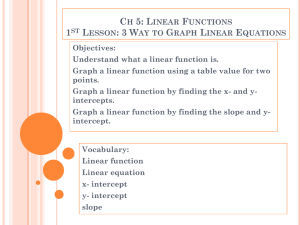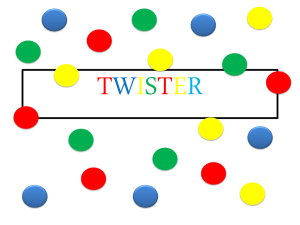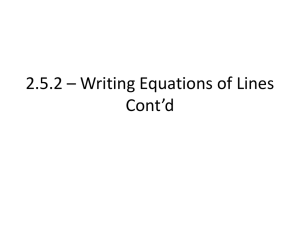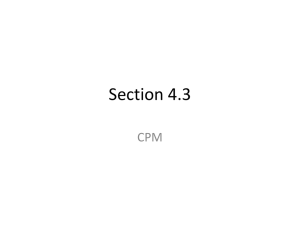Ch 4 Alg 1 07
advertisement
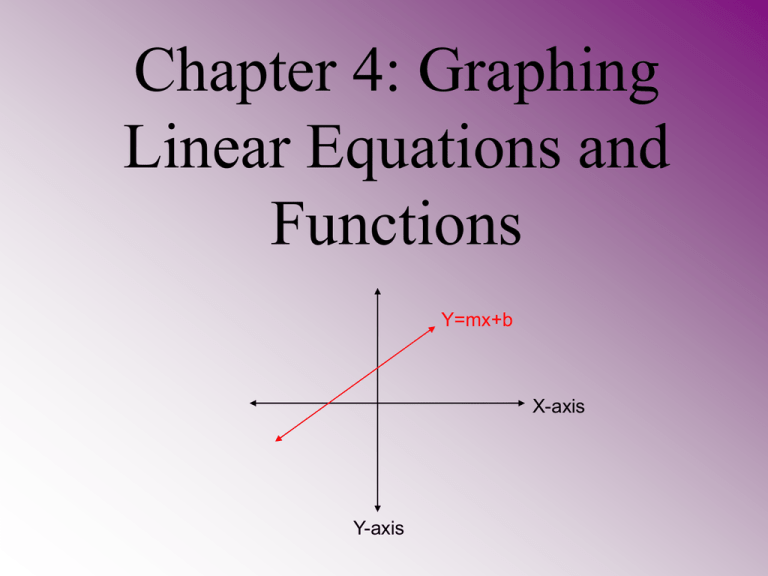
Chapter 4: Graphing Linear Equations and Functions Y=mx+b X-axis Y-axis The Coordinate Plane 4 3 2 The x-axis is the horizontal axis on a coordinate plane -5 -4 The origin occurs where the x-axis and the y-axis intersect at (0, 0) 1 -3 -2 1 2 3 4 -1 -1 -2 -3 -4 The y-axis is the vertical axis on a coordinate plane 5 Quadrants of the Coordinate Plane Coordinate planes are divided up into four quadrants: 4 3 2 Quadrant II (--, +) Quadrant I (+, +) 1 1 X-axis -5 -4 -3 Quadrant III (--, --) -2 2 3 4 5 -1 -1 -2 -3 -4 Y-axis Quadrant IV (+, --) Ordered Pairs An ordered pair consists of an x-coordinate and a y-coordinate, usually surrounded by parenthesis. The x-coordinate is always the first number. (x, y) The y-coordinate is always the second number. Example: Plot the point (3, -2) x . y (3, -2) Starting at the origin, move 3 units right and then 2 units down. Linear Equations A linear equation is written in the form Ax+By=C, where neither A nor B are zero. A solution of an equation is an ordered pair (x, y) that makes the equation true. Example: Determine whether (4, -2) is a solution of 2x+3y=2 Step 1: plug in 4 for x and -2 for y. (Remember that x is the first number in an ordered pair and y is the second.) 2(4)+3(-2)=2 Step 2: multiply and simplify. (Be sure to pay attention to any negative signs.) 8+(-6)=2 2=2 Since both sides are equal, (4, -2) is a solution of 2x+3y=2 Finding Solutions of Linear Equations The first step when finding solutions is to REWRITE the equation. Write original equation: 4x-2y=10 Move x to the other side of the equation: -2y=-4x+10 Divide by -2 to get your rewritten equation: y=2x-5 The next step is to CHOOSE x-values for your solutions and make a table. x -3 -2 -1 0 1 2 3 y -11 -9 -7 -5 -3 -1 1 Then PLUG IN the values for x in the new equation to get the y-values All of the ordered pairs on the table are solutions for the given equation. Graphing Linear Equations Using Tables By finding solutions for an equation, you are essentially finding points on the graph of that equation. Example: Graph y-2x=-1 by using a table of values. y=2x-1 Rewrite the equation: Choose x-values, make a table, and plug the x-values into the equation to find the y-values: x -3 -2 -1 0 1 2 3 y -7 -5 -3 -1 1 3 5 Plot the points on the Coordinate plane and connect the dots . . . . . . . Graphing Horizontal and Vertical Lines Graphing an equation such as x=2 or y=-1 is actually easier than it seems. When an equation is x=2, it simply means Similarly, when an equation is y=-1, that for every y-value, the x-value is 2, it means that for every x-value, the making it a VERTICAL line. y-value is -1, making it a HORIZONTAL line . . . .. x y . ... . y x X- and Y-Intercepts An x-intercept is the x-coordinate of a point where a graph crosses the x-axis. .. A y-intercept is the y-coordinate of a point where a graph crosses the y-axis. A line that is neither horizontal nor vertical has exactly one x-intercept and one y-intercep Finding Intercepts An x-intercept occurs where y=0, so to find the x-intercept, plug in 0 for y in the given equation. Example: Find the x-intercept of 7y-3x=21 7(0)-3x=21 -3x=21 x=-7 The x-intercept for this equation is -7. A y-intercept occurs where x=0, so you can plug in 0 for x in the equation to find the y-intercept. Example: Find the y-intercept of 7y-3x=21 7y-3(0)=21 7y=21 y=3 The y-intercept for this equation is 3. Graphing Using Intercepts Once you find the intercepts of an equation, you can graph that equation by plotting the intercepts and connecting the two points. Example: Plot the graph of the equation that has the intercept points (3,0) and (0,-2). . . Slope of a Line To find the slope of a line, it’s necessary to divide the rise by the run. Vertical rise=2 Horizontal run=4 Slope = Vertical rise Horizontal run = 2 4 = 1 2 Finding Slope . (x2 , y2) . y2 -y1 (x1 , y1) x2 -x1 The slope m of a line that passes through the points above is: m= rise run = change in y Change in x = y2 -y1 x2 -x1 Positive and Negative Slope If a line moves down and to the right, then it has a negative slope. Example: Let two points on a line be (1, 4) and (7, 3). Find the slope. m= 3-4 = 7-1 -1 6 If a line moves up and to the right, then it has a positive slope. Example: Let two points on a line be (6, -2) and (9, 7). Find the slope. 7-(-2) m= 9-6 = 9 3 =3 Zero and Undefined Slope The slope of any horizontal line is always zero. Example: Let two points on a line be (5, -2) and (3, -2). Find the slope. m= -2-(-2)= 0 3-5 -2 Zero divided by any number is 0. Slope is 0. The slope of any vertical line is always undefined. Example: Let two points on a line be (3, -1) and (3, 4). Find the slope. m= 4-(-1) 3-3 = 5 0 Cannot divide by zero, so slope is undefined. Direct Variation When two quantities y and x have a constant ratio k, they are said to have direct variation. If y/x = k, then y=kx. Example: If variables x and y vary directly and one pair of values is y=24 and x=3, write an equation that relates x and y. y=kx 24=k(3) 8=k Write the model for direct variation. Plug in the x and y values. Divide to find the value of k. By plugging the value of k back into the original model, an equation that relates x and y is y=8x. Slope-Intercept Form The linear equation y=mx+b is written in slope-intercept form, where m is the slope and b is the y-intercept. Example: Graph the equation y=2x-4. Step 1: Recognize that the slope is 2 and the y-intercept is -4. Step 2: Plot the point (0,b) where b is -4. Step 3: Use the slope to locate a second point on the line. m= 2 1 = rise run Move 2 units down, 1 unit right. Parallel Lines Parallel lines are different lines in the same plane that never intersect. Two nonvertical lines are parallel if they have the same slope and different y-intercepts. Any two vertical lines are parallel. The red lines are parallel to each other because they have the same slope. The blue lines are parallel to each other because they are vertical. Functions and Relations A function is a rule that establishes a relationship between two quantities, called the input and the output, where for each input, there is exactly one output. A relation is any set of ordered pairs. A relation is a function if for every input there is exactly one output. Example: Determine whether the relation is a function. Input 1 2 3 4 Output 3 5 7 The relation is not a function because the input 1 has two outputs. Vertical Line Test for Functions A graph is a function if no vertical line intersects the graph at more than one point. Function Not a function


